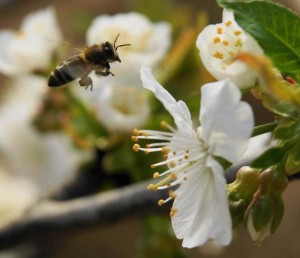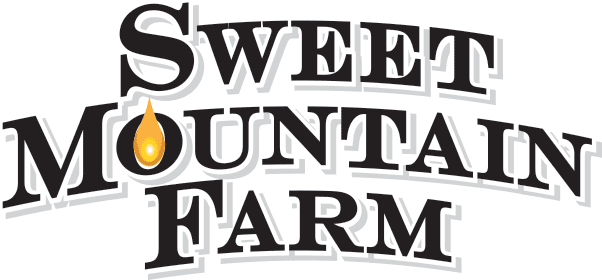POLLINATOR PLANTS
 Your choice to buy organic pollinator plants from a local farmer and your willingness to grow bee friendly plants helps to maintain a healthy environment, vibrant community, and a strong local economy.
Your choice to buy organic pollinator plants from a local farmer and your willingness to grow bee friendly plants helps to maintain a healthy environment, vibrant community, and a strong local economy.
Beekeepers need everyone to help increase the honeybee population. Bees pollinate one third of the world’s food supply yet colonies are disappearing at alarming rates in many parts of the world due to the cumulative effects of parasitic mites, viral and bacterial diseases, and exposure to pesticides and herbicides. Large scale chemical application is toxic to soil and water, and weakens our honeybees.
If you have a yard, the choices you make in your landscape and garden can support honeybee health. Attracting honeybees to a garden will help the productivity of plants through pollination. Plan a garden to provide pollen and nectar sources over an entire growing year. Even on a warm late winter day, honeybees need pollen sources to feed young brood in the hive. Plant for year-round blooming and in relative proximity to a beehive.
Honeybees commit themselves to one plant type
If dandalions are blooming at the same time as the apple trees, the honeybee will select the nectar that the colony prefers and will fully exhaust that nectar source before moving on. It is advantageous then, to cultivate one crop and plant it en mass. Workers will favor the plants that are closest to the colony. Single blossoms with anther and stamen easily accessed within the petal are better than double or trumpeted blossoms since the honeybee’s proboscis is not very long.
What plants do bees see?
Bees can see ultra-violet light and favor purple and blue flowers. Bees do not see red flowers but will be attracted to a red flower where ultra-violet light is present or there is high contrast between a flower and its background.
What plants are most nutritious?
Heirloom and wild flowers provide the most nectar and pollen while hybrids lack sufficient nutrition. A hybrids color may be vivid but its nutritional source leads the honeybee on an unproductive journey. The honeybee is driven to the sunflowers yet new pollen-less sunflowers are marketed for longer living floral arrangements.
Native versus Non-native Plants
Bees will pollinate plants that are not native to an area but are inefficient pollinating non-native plants. It is important to select plants that are local. Listed below are plants that honey bees will pollinate effectively. Not all of these plants grow in every location. According to the USDA, Washington Island is in zone 5A. When selecting plants the farm uses zone 4. Find your own zone at the National Gardening Association. If you see a plant not listed in our database below, and it is a bee friendly plant, send us the plant name so that we can build a comprehensive database. (add a plant here).
POLLINATOR PLANTS
| A | B | C | D-L |
| Acer Maple | Basil | Cabbage | Dandalions |
| Acerola | Basket-of-Gold (Aurinia saxatilis) | Cantaloupe | Digitalis |
| Ageratum | Basswood – Linden | Carambola | Dogroses |
| Ajugas | Bean Adzuki | Caraway | Echinacea |
| Alfalfa | Bean Broad | Cardamom | Echinops |
| Allspice | Bean Goa | Cashew | Eggplant |
| Almond | Bean Haricot | Catalpa (Indian Bean Tree) | Elderberry |
| Apple | Bean Kidney | Catnip | Fennel |
| Apricot | Bean Lima | Cauliflower | Flax |
| Asparagus | Bean Mungo | Celery | Foxglove |
| Aster | Bean Scarlet Runner | Cherry Sour | Geranium |
| Avocado | Bean String | Cherry Sweet | Globe Thistle |
| Beet | Chestnut | Glory of the Snow | |
| Bergamot | Clematis | Goldenrod | |
| Blackberry | Chinese Cabbage | Gourd | |
| Bleeding Heart | Chives | Grape | |
| Blueberry | Clover (not all species) | Guava | |
| Bluebells (bulb) | Clover Arrowleaf | Hazel Alder | |
| Boltonia asteroids | Clover Crimson | Hazelnut | |
| Borage | Clover Red | Heather | |
| Boysenberry | Clover White | Heath | |
| Broccoli | Coconut | Hebe | |
| Brussels Sprouts | Coffee | Helleobors | |
| Buckwheat | Calendula | Hyacinth | |
| Coneflower | Inkberry | ||
| Coriander | Jacob’s Ladder | ||
| Cosmos | Joe-Pye Weed | ||
| Cotton | Jujube | ||
| Cranberry | Karite | ||
| Crocus | Kiwifruit | ||
| Crownvetch | Lavender | ||
| Cucumber | Leopard’s Bane | ||
| Currant Black | Locust | ||
| Currant Red | Loosestrife | ||
| Lupine | |||
| M-P | Q-S | T-Z | |
| Macadamia | Quince | Tamarind | |
| Mango | Rambutan | Tangelo | |
| Marrow | Rapeseed | Tangerine | |
| Milkweed | Raspberry | Thrift | |
| Mint | Rose Hips | Thyme | |
| Mignotette | Rosemary | Tung Tree | |
| Monarda | Rowanberry | Turnip | |
| Mountain Bluet | Rudbekia | Verbena Bonariensis | |
| Mustard | Safflower | Vetch | |
| Nectarine | Sage | Viburnum | |
| Nut | Sainfoin | Walnut | |
| Okra | Salvia | Watermelon | |
| Onion | Scabious | Willows – Salix | |
| Oregano | Sedums | Winter Hazel | |
| Papaya | Sesame | Witchhazel | |
| Pea, Black-eye | Snapdragon | Zuchini | |
| Pea, Cowpea | Soybean | ||
| Peach | Squash | ||
| Pear | Starfruit | ||
| Pepper Bell | Strawberry | ||
| Pepper Chili | Sumac | ||
| Pepper Green | Sunflower | ||
| Pepper Red | Sweet William | ||
| Persimmon | |||
| Plum | |||
| Plum Hog | |||
| Pomegranate | |||
| Poplar (Yellow or Tulip) | |||
| Poppy | |||
| Primrose | |||
| Pumpkin, |
